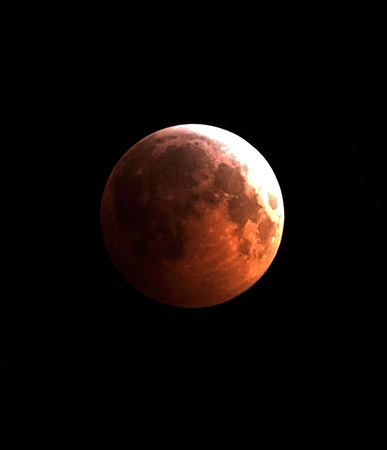Lunar Eclipse - December 2010
Optics: Borg Astrograph 101ED at f/6.6
Mount: Atlas EQ-G
Camera: Canon EOS 50D [ UV/IR filter modification by Hap Griffin ]
Filters: None
Exposure: 0.5 Secs at ISO 100
Accessories: None
Location: Calgary, AB
Date: December 21, 2010 - 12:40AM
Notes: Processing: Image acquisition with Maxim DSLR. Image calibration, resize in Photoshop. Temperature -14.5C
This photo is from our recent 2010 Lunar eclipse. This exact shot was taken just prior to reaching totality which occured 1 minute later at 12:41AM. This is one out of 121 shots taken.
Total Eclipse of the Moon
The Moon is seen during totality during the lunar eclipse of December 21, 2010. This was a rare eclipse, occurring on the day of the northern hemisphere's winter solstice, the first since 1638, some 372 years ago.
Although no direct sunlight hits the Moon during the total phase of a lunar eclipse, the Moon is visible from sunlight refracted through the Earth's atmosphere during the eclipse. The eclipsed Moon gets its usual burnt orange color from scattering of blue light from the Sun's spectrum in the Earth's atmosphere. This is the same reason the Sun appears red at sunset, and that the sky is blue in the daytime.
During totality, the Moon is illuminated by all of the sunsets occurring simultaneously around the rim of the Earth as seen from the Moon.
"above notations taken from Astropix.com"
Our first Total Lunar Eclipse in nearly 3 years occurs on the night of Dec 20 and into the early hours of Dec 21. Albertans should see the earth's shadow start to move across the face of the moon around 11:00 pm on Dec 20. Total eclipse will begin at 12:41 am Dec 21. The moon will move out of the earth's dark umbral shadow at 1:53 am. The partial eclipse ends at 3:01 am. The eclipsed full moon will not go black but will turn a dark reddish colour. The reddish colour is a result of all the combined sunrise and sunsets that are occurring around the earth's edge.
The next total lunar eclipse occurs on June 15, 2011 but is not visible from North America. The next total lunar eclipse for us in North America occurs on April 14-15, 2014.


